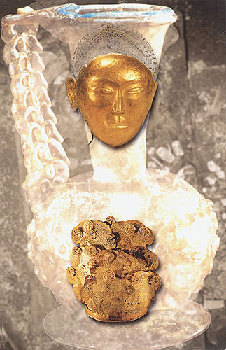Tomb of Khitan (Qi Dan) aristocracy
Location: Naimen Banner, Zhelimu League,Inner MongoliaAutonomous Region
Period: 1018 AD
Excavated in 1986
Significance: It has supplied important materials to the study of the social, political, economic, and historical developments and other social aspects of the Khitan people in the Liao period, as well as cultural exchanges between the Han people and the Khitan people.
|

|
| Gold mask and a net sewn with silver thread: burial set (up, the length of the mask is 21.7 cm); Silver hat gilded with gold: burial set (bottom, height 31.5 cm); Glass jar with long neck and nipple design: wine vessel or water vessel (in the background, height 17 cm) |
 Introduction
Introduction
The discovery in 1986 of the joint tomb of the Princess of the State ofChenand her husband at Qinglongshan, Naimanqi, Zhelimu League in southeastInner Mongoliarevealed an unprecedented lavishness in burial dress that stunned the archaeological world. Here, for the first time, was an undisturbed royal tomb of the Liao Dynasty (916-1125) that dated from a little understood period in history when the semi-nomadic Khitan people ruled over a large part of northeastChina.
The tomb has six parts: the grave tunnel, dooryard, front chamber, east wing room, west wing room, and main chamber, with a total length of 16.4 meters. There are many colorful paintings on each side of the grave tunnel and the coping of the chamber and wing rooms.
The royal pair was interred side by side on a wooden funerary couch with their heads resting on gilded-silver pillows. Their rich clothing and personal adornment provide visual evidence of elite Khitan burial custom that they hoped would assure a luxurious hereafter. Many of the items areMingqi(spirit objects), having been designed for the grave rather than real life.
Each corpse was encased in a silver-wire mesh body suit that extended from the head to the toe. A gold death mask, an ornate headdress, earrings, a belt with gilded mounts hung with necessary accessories, and gilded-silver boots completed each outfit, along with clothing made of real fabric that had long ago disintegrated. Spare belts and other luxury items were scattered around their heads.
 Cultural Heritage
Cultural Heritage
In many instances, the clothing and adornment are gender specific, proclaiming the sex of the wearer. A mustache distinguished the prince's mask, while seriously male accessories, such as a small knife and an awl, were hung from his belt. By contrast, the princess' belt carried feminine paraphernalia, including gold purses, jade tools and crystal containers.
The majority of the metal objects were made of hammered silver decorated in repoussé with phoenixes, cloud scrolls and Daoist figures, the details refined by chasing, and then the surfaces mercury-amalgam gilded. The headdresses were formed by several gilded-silver hammered sheets with chisel-cut openwork decoration enhanced by chasing, and then wired together. The boots were also made with hammered silver sheets but joined by soldering, rather than wire, after being decorated in repoussé with specific zoomorphic motifs: phoenixes for the princess and dragons for the prince.
Besides the lavish number of artifacts made of gold and silver, the grave goods also included superb ornaments made of amber, jade, crystal and agate.
